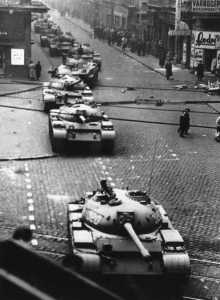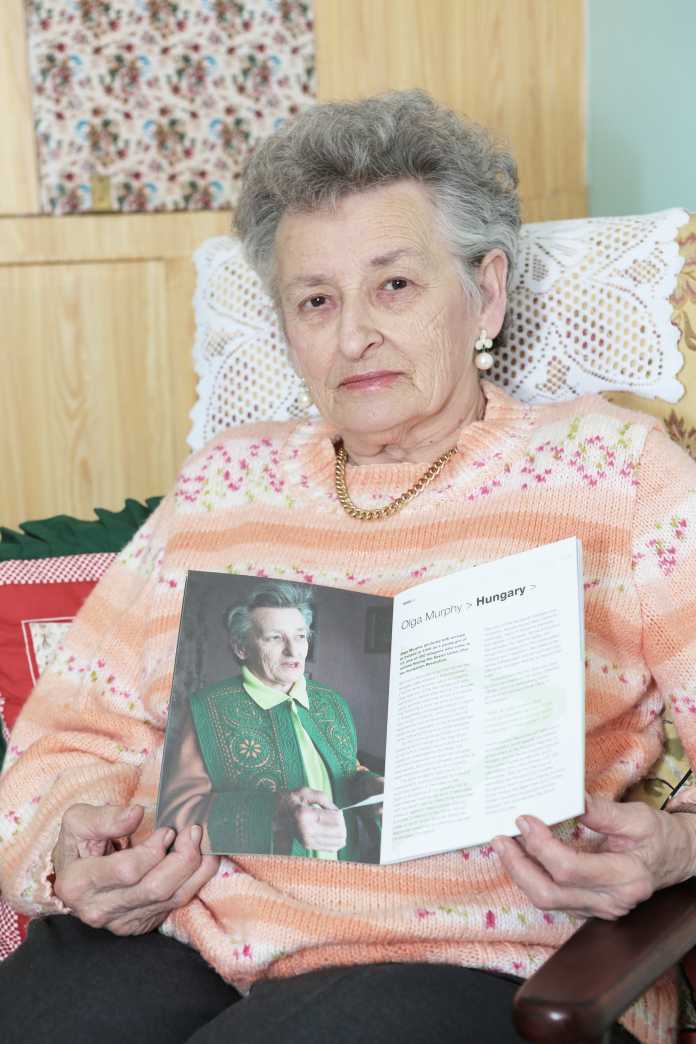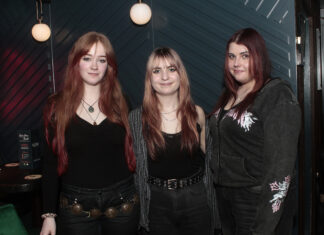
Photo: Liam Burke/Press 22
As Ireland prepares to welcome some 4,000 refugees from Syria, some Limerick locals may recall that the city was home to Ireland’s first refugees in 1956.
Kathy Masterson speaks to Olga Murphy, the last of the 500 Hungarian refugees who were housed in Knockalisheen army barracks.
IN AN ordinary house in an ordinary estate in Limerick lives a 76-year-old woman who insists that she is “not a very interesting person”.
At first glance, Olga Murphy could be a typical Irish grandmother: she enjoys her weekly bingo, loves her two cats, and is proud of her needlework skills.
But looks can deceive, Olga also fought against the Soviet army when she was just 17 years old, and for a time was in danger of being executed in her native Hungary.
Once a refugee living in a disused army barracks, Olga has since made Ireland, more specifically Moyross, her home, and has even had tea with President Higgins.
When I meet her, she seems bemused as to why so many people seek her out for interviews (just last week she featured on RTÉ Radio One’s Sean O’Rourke show).
“So, what do you want to know?” she asks, in an accent that still has strong traces of Central Europe, almost 59 years after she left.
I ask her what had happened to make her leave Hungary as a refugee at 17.
“There was a revolution in 1956 in Hungary and I was in the revolution and I had to get out of the country because they would have hanged me or shot me if I stayed.
“What really got me into the revolution was that one day when I was 17, I was going home from college. I saw a child, a little boy four or five years of age, running across the road looking for his mother, and a Russian soldier with a machine gun gunned him down from head to toe.
“Then they accused me of having shot the chief of police. Whether I did or not, I don’t know. There were so many people shooting and so many people were shot. They were looking for me for two years; my mother was sending me the newspaper cuttings.
“That’s how I ended up here. Everybody had to go into Austria, and as Austria is a really small country, it was so overloaded that they had to ask some other countries in Europe if they could take us for six months.
“I was only supposed to be in Ireland for six months, I’ll be here 59 years in November. It was a very long six months.”
Olga says she and her fellow countrymen and women were “treated like VIPs” on their journey across Europe.
However, when they reached their final destination of Knockalisheen on the outskirts of Limerick, they found themselves living in a cold, dreary, abandoned army barracks with few home comforts.
Olga recalls: “It was an army training camp and, oh my God, this old timber barracks. We came in November and it was fierce cold. Eventually they got some hard wood to insulate it to a certain extent. In the summer it was lovely, but it was muddy, there were no showers, no bathrooms. There was just one big building, that was the army washroom, and there was just a big sink to get washed so you can imagine how hard it was. We were there for two years.
“When I first came, I didn’t like the look of it. I would have preferred to have been in a decent house, but I said to myself ‘At least I’m free. I don’t have to look over my shoulder, wondering if I might say something wrong, or if somebody might say something against me’.
“Anyway, I didn’t want to be shot or hanged by the Communists. No way, I wouldn’t give them the satisfaction. If I was shot during the Revolution, that’s one thing. I knew when I went into it that that could happen. But for them to just shoot me? No way, I’m too stubborn for that.”
Referring to the current direct provision centre at Knockalisheen, Olga says the asylum seekers living there today are “lucky”.
“They are in a decent house; they have a bathroom, they have a shower. We knew that Ireland was poor, we didn’t expect God knows what. You just had to grin and bear it or groan and bear it, one or the other, and we appreciated what we got.”

Photo: Liam Burke/Press 22
Olga married an Irishman in 1959, and had two sons. She now has a granddaughter and three great-grandchildren, with a fourth on the way.
Having arrived to Ireland with “not a word of English”, Olga quickly learned the language and made friends.
In the 1960s, she worked at the Krups engineering factory and was promoted to supervisor, astounding her manager, the late John Lovett, when she revealed she had never been to school in Ireland, and never attended English classes here.
“I never regretted staying in Ireland; I never wished to leave Limerick. I love the Limerick people. From the word go, they never made us feel like we were outsiders, that we were unwelcome.
“We were quarantined for two weeks when we came. Then, when we were let out, a bunch of us came from Knockalisheen – we had to walk all the way, there were no buses then. We got to Watch House Cross, and half of Kileely was there – old ones, young ones, prams and wheelchairs, you name it. They knew we were coming out and they were waiting. They were shouting at us in English and we were shouting back in Hungarian – it was like the Tower of Babel. They followed us halfway into Limerick; it was like a St Patrick’s Day procession.”
Olga says she never suffered from homesickness, and attributes the ease with which she adapted to her young age.
“I was only 17 when I came here and the younger you are, the easier it is to settle; you adjust yourself to the way of life. I never longed to go back. I went a few times to see my family, but there is nobody there now. My mother is dead, father is dead, my sister is dead.
“The first time I went back (to Hungary) was in 1978. On one side of the runway was a soldier with a machine gun and a big huge dog. A few hundred yards down, there was another one on either side. When I saw that I thought ‘Oh God let the plane turn around and go back to Ireland’. It gave me the most horrible feeling. My mother wanted me to stay. She said ‘here is the house, you can have it when I’m dead’. But I could not imagine life back there. Things got a bit better after the Revolution, but I always remember it the way it was when I left it.
“It was very hard then. You had to be very careful what you said. You couldn’t go and complain about the government in the newspaper, you couldn’t say it out loud. If you said to a policeman ‘go to hell’, they would put you in jail for six months. Not because you insulted the man, but because you insulted the uniform. If your family wasn’t Communist, they discriminated against you in a subtle kind of way in school and in the workplace.”
Olga recalls that a friend who returned to Hungary once told her that she felt there was an unspoken prejudice against those who had left in 1956.
“She said ‘nobody bothered us, as in no guards came to our house’ but she couldn’t rise up in her job. She said people were promoted who weren’t there as long as her; she was kind of put aside. They wouldn’t say anything, they wouldn’t question you why you left or why you came back, but they had a way of showing you.”
Olga is now the only remaining 1956 Hungarian refugee in Ireland. The rest returned to Hungary, or travelled further afield to the USA, Canada or Australia.
As the sole representative of the first group of refugees to be given amnesty in Ireland, Olga has been the subject of media attention in the past and has been invited to attend a number of prestigious celebrations.

One of these was an intercultural garden party hosted by President Michael D Higgins in Áras an Uachtaráin in June of this year to celebrate World Refugee Day.
“In his speech, he talked about the first refugees from Hungary, I nearly burst into tears when I heard that he remembered us, but of course he was a Limerick man so he would have known about us. I went up to some of his aides afterwards and I asked if I could speak to the President for a couple of minutes. He stopped and I said to him ‘I want to thank you for remembering the Hungarian refugees’.
He took both of my hands and he said ‘I remember them well’”.
The plight of the refugees of today is something that strikes a chord with Olga. However she warns that those travelling to Europe from Syria and elsewhere should be realistic about their expectations of what life will be like when they arrive.
“What’s happening in the news now in Hungary, I didn’t like what they did, with the tear gas and the water cannons. But those people don’t understand that you have to be patient. When I was in Knockalisheen, some of the men went on a hunger strike for the simple reason that they wanted to get out of Ireland. We were only brought her for six months. When a year was up, they wanted to go to America, Canada or Australia.
“My heart goes out to the refugees, and I feel so sorry for them. I know what they’re going through. I know what it is to leave your country, leave your family with nothing but what’s on your back. I went through it and I understand. But we weren’t the amount of people that are coming now. They just have to be patient, they have to realise that there aren’t enough trains to carry them.”
By the time I take my leave of Olga, our trip down memory lane has taken its toll.
She concludes: “No one really knows how hard it is to be a refugee unless you experience it. You can only imagine from what you see on the television and in the paper.
“As I’m sitting here now talking about it, it still brings a lump to my throat. I feel sad thinking about it when I am interviewed. No matter how long ago it was, how young you were and whatever happens to you in life, you never forget it.”
Ireland’s first refugees
AS THE Soviet military fought to crush the Hungarian Uprising of 1956, approximately 170,000 refugees from Hungary fled to Austria and the former Yugoslavia.
Refugee camps were soon full to capacity, and Ireland was among a number of countries to offer asylum.
The then Taoiseach Eamon de Valera pledged to take in 1,000 Hungarian refugees, giving preference to Catholic families from professional backgrounds.
Only about 520 of the expected 1,000 refugees came as the Irish State was unable to provide a second camp.
All were housed by the Red Cross in the former army barracks at Knockalisheen.
The refugees, for the most part, received a warm welcome from locals.
At the time, Ireland itself was struggling economically and some 40,000 Irish people were emigrating in search of employment each year.
Some of the Hungarians at Knockalisheen staged a hunger strike in 1957 in protest at their poor living conditions and lack of employment opportunities.
Most of Ireland’s Hungarian refugees left for Canada in 1957 and 1958 with the help of UNHCR (United Nations High Commissioner for Refugees).
The Hungarian Uprising of 1956

HUNGARY had been under Russian control since 1945 and thousands of Russian troops were posted there to impose Soviet rule.
On October 23, 1956, students and workers took to the streets of Budapest and issued their Sixteen Points, a list that included calls for personal freedom, more food, the removal of the secret police, and the removal of Russian control.
The move followed protests in Poland in 1956 that resulted in the granting of additional rights to citizens there.
Also in October 1956, students, workers and soldiers attacked the AVH (the secret police) and Russian soldiers, and smashed a statue of Stalin.
On November 4, 1956 1,000 Soviet tanks were sent to Budapest to restore order; approximately 4,000 people were killed, and tanks dragged bodies through the streets of the capital as a warning to protesters.
By November 14, Soviet rule was re-established and order had been restored, but thousands of Hungarians had already fled the country as refugees, thousands of others were arrested and imprisoned.
Following the Revolutions of 1989, Hungary’s border with Austria opened and the Communist state fell apart.
Soviet forces finally withdrew in 1991.






